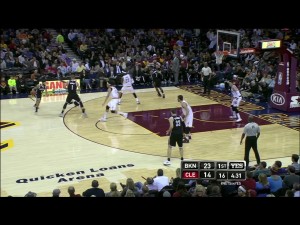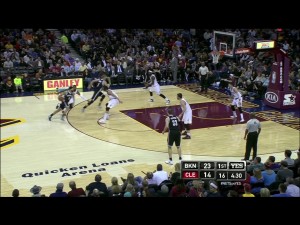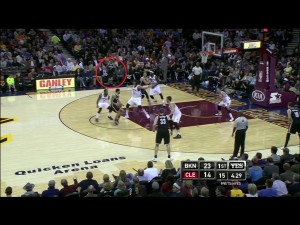The Pros to Mason Plumlee
After an eight-game absence that’s spanned two weeks, Brook Lopez’s return had become the dangling plot thread in the tragedy that is the Brooklyn Nets’ 2014-15 season. Columns have been written about Brook’s impact on the Nets offense and how his return will affect the spacing and swinging of the ball that’s afflicted the team of late, but the recent play of Mason Plumlee has altered the conversation a bit. Tim Bontemps of the New York Post made “the case for keeping Brook Lopez out of the starting lineup” in his piece on Monday, breaking down the various (and logical) points as to why he believes Mason Plumlee’s recent performance in the starting lineup merits an extended look.
There are many facets to this topic that can’t possibly be solved in a single write-up. I posed the question to the guys on this week’s Three Man Weave and all three of them brought up interesting aspects to benching Brook, agreeing that keeping Mason Plumlee in the starting lineup could be a short-term option as Lopez works his way back to 100% health but it would be a long-term commitment that might require a trade to work. He has to get healthy before he can build enough trade value to return anything of worth to the Nets, and as Bontemps points out, Brook’s proficiency in the low post would bolster a bench unit that’s struggled for the Nets all season, particularly in second quarters. Lionel Hollins downplayed the conditioning concerns earlier in the week but brought Lopez off the bench for limited minutes against the Denver Nuggets Tuesday night in his return from the back strain.
Again, there’s nuance to this debate and different angles to explore, and an argument as to whether the Nets should make major trades and really deal one of its “Big 3”, as Marc Stein and Ohm Youngmisuk reported that management has considered, is at the forefront of any lasting discussion of Plumlee’s place in the starting lineup. That’s for another day. Let’s look at some of the unique skills that Mason Plumlee brings to the team, and why he should continue starting for the Brooklyn Nets.
Style of Play
First, let’s address the size and style of play discrepancy between Brook Lopez and Mason Plumlee. Lopez is a seven-foot, 275-lb. post-scorer and occasional mid-range jump shooter with a career usage rate of 25.1%. Plum, on the other hand, checks in at 7’1” and 238 lbs., and gets his points by cutting to the rolling off a screen or from the baseline, with a (two-year) career usage of 18.4%. Almost 95% of Plumlee’s shot attempts have come within ten feet of the basket this season, while those shots constitute about 70% of Lopez’s offense.
Mason’s mobility and quickness lay at the heart of his effectiveness within the Nets starting lineup and allows him to attack defenses in completely different ways than Brook can, as a shot-finisher instead of a shot-creator (even if Brook can only create that shot for himself). Brook is more skilled with the ball and does so many more things on offense than Plum is able to, but gives the advantage back with his lack of speed and inability to make plays without the ball in his hands. In a lineup with veterans like Kevin Garnett, Deron Williams, and Joe Johnson, Plum’s athleticism and willingness to move the ball opens up opportunities and adds a dimension that the team lacks otherwise.
Passing
It might be fair to say that passing the basketball isn’t exactly a necessary skill required of centers in Lionel Hollins’s offense, as all three center options (Plumlee, Lopez, and Jerome Jordan) average under an assist per game on the season. Plumlee might be the best passer of the group, at least by assist percentage, as he uses his mobility and lack of a post game to move the ball in sometimes creative ways.
I grabbed a clip from last Tuesday’s Heat loss (which of course led to a missed corner-three-point attempt) that showed some of Plum’s agility. Plumlee begins by trying to set a high screen for Jarrett Jack but then dives down the middle of the lane, receiving the (bullet) pass underneath the basket from Joe Johnson after a ball-swing. As good dive-men off the pick-and-roll tend to do, he drew not only his own man by diving to the rim after his (attempted) screen but also the help defender (Dwyane Wade, who loves to roam and over-help), freeing up an open look from the corner. It’s really a high-coordination move from Mason Plumlee, as he reacts to the catch, upfakes in the paint to keep the defense doubling, and then faces up to the middle to throw the chest pass to the opposite side to hit Sergey Karasev for a catch-and-shoot opportunity. Don’t let the missed shot overshadow what was otherwise an excellent job by Plumlee to generate a good look for a teammate by running hard and then recognizing the open spot in the defense.
Fast Breaks
This is a concept that Plumlee alone brings to the offense, as Lopez and Jordan are more “lumbering” than “agile”. Running hard on the fast break creates early opportunities and switched defensive assignments for a team that might not otherwise look to run, and Plum’s ability to catch lobs at the rim after beating his man up the court adds some much-needed verticality to the Nets’ offense.
This play from Sunday’s win against the Pistons came off of a takeaway on defense in which Bojan Bogdanovic pushed the ball, found point guard Darius Morris up the court and Morris left it for a streaking Plumlee. He’ll beat bigger centers like Andre Drummond up the court pretty easily but notice the trailing Jonas Jerebeko, himself a quicker player who has played either forward spot in his career.
Here’s another example of the havoc that Plumlee’s fast-breaking can have on the opposing D. He beats Udonis Haslem up the court and forces Danny Granger to step up to stop the oop, leaving Joe Johnson uncovered in the opposite corner. Mason catches as he’s falling towards the baseline and kicks it back out to the perimeter. Deron then has multiple options after he upfakes and gets into the paint: dish it out to his right to a still-uncovered Joe Johnson or wrap-around pass to Mason Plumlee as he lurks on the left baseline. He chooses the latter option, Mason unleashes his patented reverse-dunk, while Granger looks on in confusion.
Baseline Cuts/Hanging Around the Basket
Unlike Lopez, or even Jerome Jordan to an extent, Mason Plumlee lacks a competent post-up game that he can rely on to get easy baskets. He’ll flash a right-handed jump hook on occasion or when matched up against smaller defenders but lacks some of the advanced post moves and touch of the other Brooklyn bigs, instead excelling at finishing off of other players’ penetration or putting back offensive rebounds. Like a poor man’s Tyson Chandler, Plumlee scores the majority of his points by rolling to the basket or hanging around the paint for scraps. He has good instincts of where to position himself while playing off of his teammates or which angles to pursue while sniffing out put-back dunks.
This play is a great example (if not great camera-work) of how Plumlee can find soft spots in the defense and play off of his veteran teammates when not directly involved with the play. Deron Williams and Kevin Garnett run a lot of high screens together - due to KG’s sneaky screen-setting skills and ability to hit the pick-and-pop jumper - and the Miami Heat are a team that’s been notorious under Erik Spoelstra for playing aggressively and blitzing ball-handlers to all spots of the court. Here KG leaks out after setting the screen and gives Deron Williams a target in the middle of the court to pass to, as he gets double-teamed to near half-court. The Big Ticket takes it from there, drawing the help defense to just below the free-throw line and giving himself enough passing angles to find the open man lurking along the baseline. Plumlee gets an easy reverse dunk. In the Nets’ last game, against the Denver Nuggets, Plumlee had a louder example just from hanging around the restricted area as a teammate gets deep position and draws the defense. He’s still struggling shooting at the rim compared to last season (75.9 FG% on shots within three feet of the basket in 2013-14, 58.3% this season), but rarely ventures outside of the paint with his offense and knows his limitations.
Diving Off of the Pick-and-Roll
To illustrate this point, let’s go to the pictures. Deron Williams starts the play with the ball on the left side and uses a Plumlee high screen to go to his right, with Joe Johnson curling to the left corner and Mirza and Bojan spacing the court from the right elbow and corner.
LeBron James’s Cleveland Cavaliers play the pick-and-roll more conservatively than his Miami teams did, with Anderson Varejao hanging back a bit on his coverage and meeting Deron at the free-throw line. Plumlee runs hard into the lane and LeBron is forced to body/chip him to prevent an easy basket at the rim, leaving Joe Johnson wide open from the left corner. LeBron James, one of the smartest defenders in the league, had to make a decision at that moment: prevent a layup or alley-oop from Plumlee or stick with Joe Johnson on the three-point line. LeBron stayed to help on Plumlee and Deron turned it over by forcing it inside instead of kicking it out to Joe Johnson for the open jumper. To be fair, Joe was tough to see, hence the big red circle.
Brook Lopez is also effective at rolling to the basket and taking up space, thanks to his size and strength. Brook’s rumbling to the rim attracts a different kind of reaction than Plumlee’s, and his screens might be tougher to fight through, but I’ve yet to see Brook Lopez pull off one of these…
Chase-Down/Weak-Side Shot-Blocking
Another example of Mason Plumlee using his athleticism to make positive plays for the Brooklyn Nets, but this time on the defensive end. This play comes after a loose ball and a seemingly two-on-none fast break between Kyrie Irving and LeBron James. Plum doesn’t quit, however, and uses a speed burst to block Irving’s layup from behind and off the backboard. LeBron collects the offensive rebound, upfakes, and then shrugs off a diving foul from Plumlee. Earlier in the first quarter of that game, Plumlee flashed his athleticism in the half-court by challenging LeBron James at the rim. The Cavs ran a nice set that would otherwise get LeBron a layup, by faking the high screen and bringing the opposing big man up, but then swinging to the weak side and getting LeBron one-on-one on Joe Johnson with an open paint behind him. Plum doesn’t get too far upcourt and keeps an eye on the James drive, recovering in time to block the shot out of bounds and save two points.
Plumlee still needs to show consistency on the defensive end, and focus his energy and athleticism into sustaining his flashes of strong play. He’s not a great one-on-one defender, especially in the post, but he’s been good at defending at the rim this season, surrendering 52.5% shooting within five feet of the basket. He blocks about 4% of opponents’ shot attempts while on the floor, which is slightly less than Brook Lopez’s 4.7% and Jerome Jordan’s 4.2%, but he also has the athletic tools to step out to take charges and get back on defense to prevent fast breaks. It’s all about reps and consistent minutes at this point in Plumlee’s development, but he could eventually be a good defender at the NBA-level.
Before Lionel Hollins can even begin to contemplate Mason Plumlee’s permanence in the starting lineup, the Nets’ upper management must first decide their direction going forward. A month ago he was barely getting into games under his new head coach, and being asked to play in the post more in a new offense. Over the last week of the season he’s been the best Net on the floor. General manager Billy King reportedly considers Plumlee a “significant part of [his] future core” but if Brook Lopez returns to the starting lineup it’ll be interesting to see if Plumlee goes back to struggling to find minutes in a bench frontcourt with Jerome Jordan.
Based off of his performance in the starting lineup and the energy and athleticism he brings to the team, Mason Plumlee deserves more opportunities to run with the starters and log heavy minutes. Looking to the future might be a stretch for an organization that won’t own a first-round pick until 2019, but developing the team’s under-25 talent (Plum, Bogdanovic, Karasev) should at least be a consideration, especially for a team this starved for athleticism and excitement.
Brook Lopez needs to work his way back into the rotation and recover some of his lost foot speed, but should eventually reclaim his lost starting spot. The Nets might be an eighth-seed in the Eastern Conference with him or Plumlee manning the pivot, thanks to the weakness of the East. It’s up to the Nets organization to answer the tough questions and determine their direction over the last two-thirds of the season, but they can’t overlook the upside that Mason Plumlee brings to the Brooklyn Nets starting lineup.


